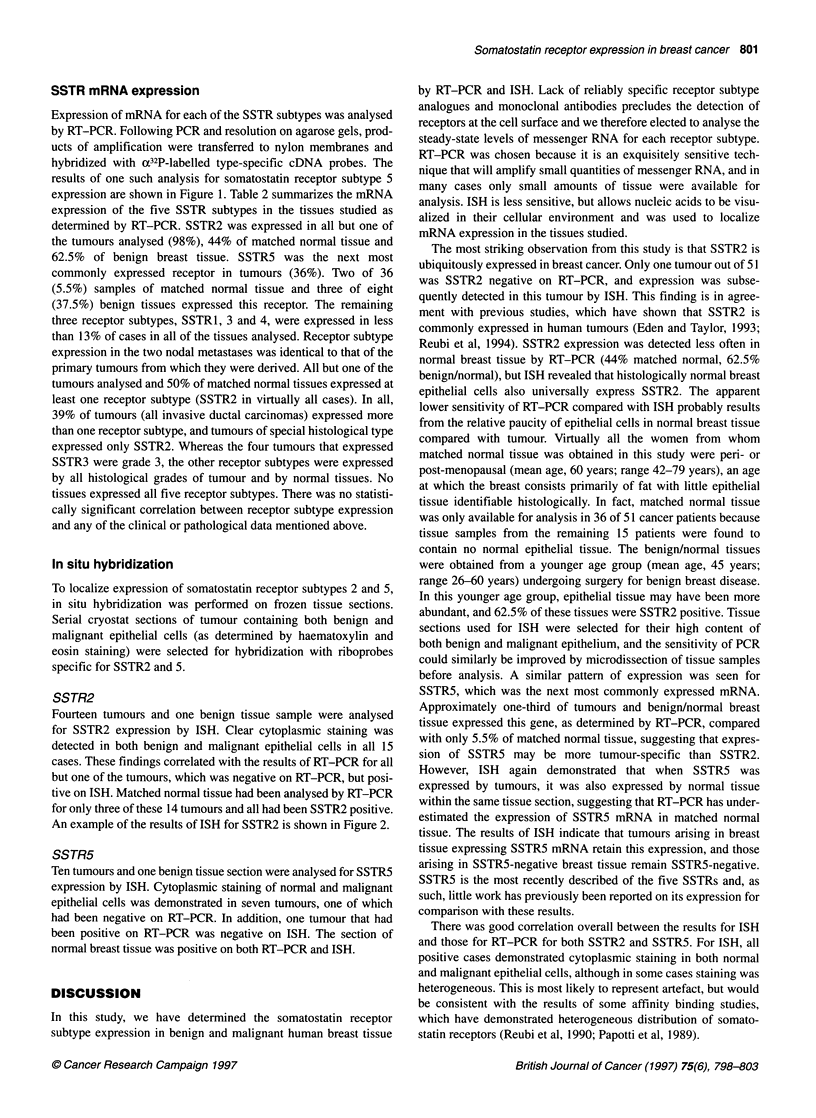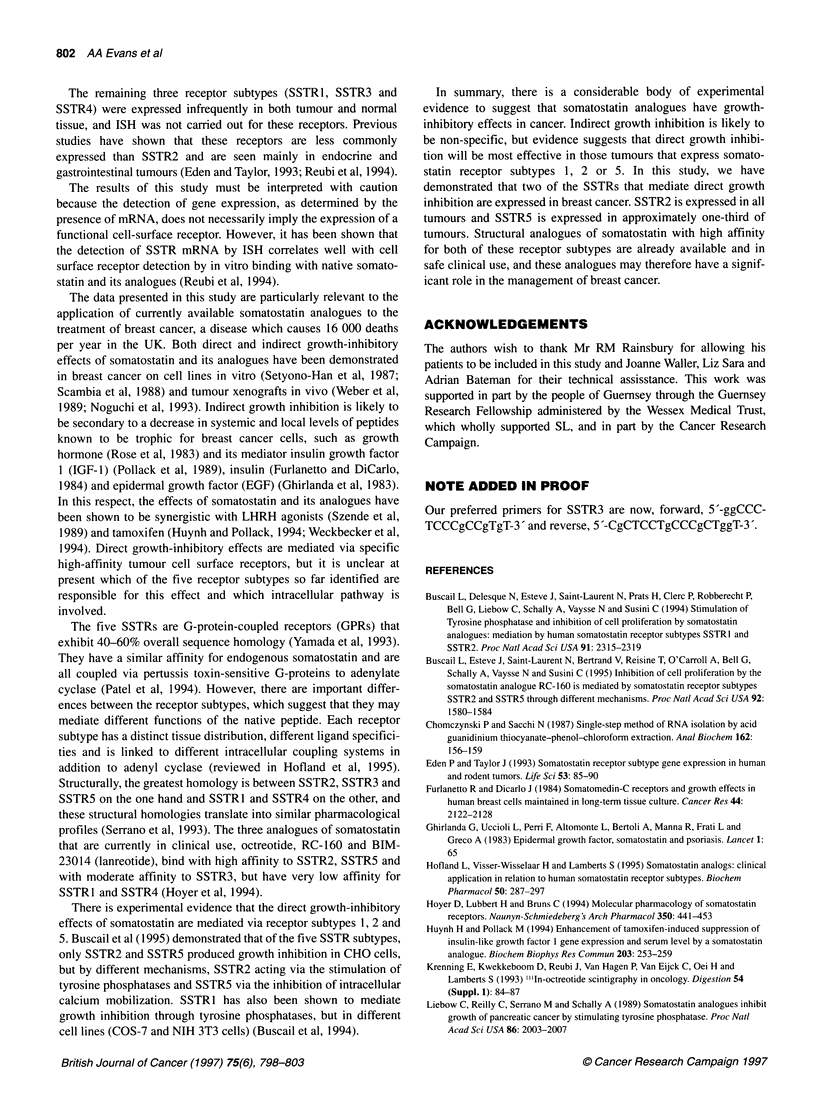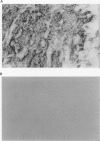Abstract
Somatostatin is a widely distributed inhibitory peptide with growth-inhibitory effects in several human tumours, including breast cancer, raising the possibility that it may have therapeutic potential. The effects of somatostatin are mediated via a family of cell-surface receptors that differ in their tissue distribution, pharmacological properties and intracellular response mediators, suggesting that they mediate different functions of the peptide. We have analysed the expression of somatostatin receptor subtype (SSTR1-5) mRNA in normal and malignant breast tissue. Receptor expression was analysed by reverse transcription-polymerase chain reaction (RT-PCR) using receptor subtype-specific primers and by in situ hybridization (ISH) with riboprobes synthesized by in vitro transcription of cloned PCR products. A total of 51 breast carcinomas, 36 samples of matched normal tissue, two axillary node metastases and eight normal/benign breast tissue samples were analysed. SSTR2 expression was ubiquitous in both normal and malignant breast tissue. Expression of SSTR5 was detected in approximately one-third of tumour and normal tissue, but fewer than 13% of all tissues expressed SSTR1, 3 and 4. These data suggest that SSTR2 gene expression is ubiquitous in breast cancer. Although this is unlikely to have diagnostic or prognostic significance, SSTR2-specific somatostatin analogues may have therapeutic potential in breast cancer.
Full text
PDF





Images in this article
Selected References
These references are in PubMed. This may not be the complete list of references from this article.
- Buscail L., Delesque N., Estève J. P., Saint-Laurent N., Prats H., Clerc P., Robberecht P., Bell G. I., Liebow C., Schally A. V. Stimulation of tyrosine phosphatase and inhibition of cell proliferation by somatostatin analogues: mediation by human somatostatin receptor subtypes SSTR1 and SSTR2. Proc Natl Acad Sci U S A. 1994 Mar 15;91(6):2315–2319. doi: 10.1073/pnas.91.6.2315. [DOI] [PMC free article] [PubMed] [Google Scholar]
- Buscail L., Estève J. P., Saint-Laurent N., Bertrand V., Reisine T., O'Carroll A. M., Bell G. I., Schally A. V., Vaysse N., Susini C. Inhibition of cell proliferation by the somatostatin analogue RC-160 is mediated by somatostatin receptor subtypes SSTR2 and SSTR5 through different mechanisms. Proc Natl Acad Sci U S A. 1995 Feb 28;92(5):1580–1584. doi: 10.1073/pnas.92.5.1580. [DOI] [PMC free article] [PubMed] [Google Scholar]
- Chomczynski P., Sacchi N. Single-step method of RNA isolation by acid guanidinium thiocyanate-phenol-chloroform extraction. Anal Biochem. 1987 Apr;162(1):156–159. doi: 10.1006/abio.1987.9999. [DOI] [PubMed] [Google Scholar]
- Eden P. A., Taylor J. E. Somatostatin receptor subtype gene expression in human and rodent tumors. Life Sci. 1993;53(1):85–90. doi: 10.1016/0024-3205(93)90614-9. [DOI] [PubMed] [Google Scholar]
- Furlanetto R. W., DiCarlo J. N. Somatomedin-C receptors and growth effects in human breast cells maintained in long-term tissue culture. Cancer Res. 1984 May;44(5):2122–2128. [PubMed] [Google Scholar]
- Ghirlanda G., Uccioli L., Perri F., Altomonte L., Bertoli A., Manna R., Frati L., Greco A. V. Epidermal growth factor, somatostatin, and psoriasis. Lancet. 1983 Jan 1;1(8314-5):65–65. doi: 10.1016/s0140-6736(83)91594-5. [DOI] [PubMed] [Google Scholar]
- Hofland L. J., Visser-Wisselaar H. A., Lamberts S. W. Somatostatin analogs: clinical application in relation to human somatostatin receptor subtypes. Biochem Pharmacol. 1995 Jul 31;50(3):287–297. doi: 10.1016/0006-2952(95)00066-9. [DOI] [PubMed] [Google Scholar]
- Huynh H., Pollak M. Enhancement of tamoxifen-induced suppression of insulin-like growth factor I gene expression and serum level by a somatostatin analogue. Biochem Biophys Res Commun. 1994 Aug 30;203(1):253–259. doi: 10.1006/bbrc.1994.2175. [DOI] [PubMed] [Google Scholar]
- Krenning E. P., Kwekkeboom D. J., Reubi J. C., van Hagen P. M., van Eijck C. H., Oei H. Y., Lamberts S. W. 111In-octreotide scintigraphy in oncology. Digestion. 1993;54 (Suppl 1):84–87. doi: 10.1159/000201083. [DOI] [PubMed] [Google Scholar]
- Liebow C., Reilly C., Serrano M., Schally A. V. Somatostatin analogues inhibit growth of pancreatic cancer by stimulating tyrosine phosphatase. Proc Natl Acad Sci U S A. 1989 Mar;86(6):2003–2007. doi: 10.1073/pnas.86.6.2003. [DOI] [PMC free article] [PubMed] [Google Scholar]
- Noguchi S., Nishizawa Y., Motomura K., Inaji H., Imaoka S., Koyama H., Matsumoto K. Inhibitory effect of a somatostatin analogue (SMS 201-995) on the growth of androgen-dependent mouse mammary tumor (Shionogi carcinoma 115). Jpn J Cancer Res. 1993 Jun;84(6):656–663. doi: 10.1111/j.1349-7006.1993.tb02026.x. [DOI] [PMC free article] [PubMed] [Google Scholar]
- O'Carroll A. M., Raynor K., Lolait S. J., Reisine T. Characterization of cloned human somatostatin receptor SSTR5. Mol Pharmacol. 1994 Aug;46(2):291–298. [PubMed] [Google Scholar]
- Papotti M., Macrí L., Bussolati G., Reubi J. C. Correlative study on neuro-endocrine differentiation and presence of somatostatin receptors in breast carcinomas. Int J Cancer. 1989 Mar 15;43(3):365–369. doi: 10.1002/ijc.2910430302. [DOI] [PubMed] [Google Scholar]
- Patel Y. C., Greenwood M. T., Warszynska A., Panetta R., Srikant C. B. All five cloned human somatostatin receptors (hSSTR1-5) are functionally coupled to adenylyl cyclase. Biochem Biophys Res Commun. 1994 Jan 28;198(2):605–612. doi: 10.1006/bbrc.1994.1088. [DOI] [PubMed] [Google Scholar]
- Pollak M. N., Polychronakos C., Guyda H. Somatostatin analogue SMS 201-995 reduces serum IGF-I levels in patients with neoplasms potentially dependent on IGF-I. Anticancer Res. 1989 Jul-Aug;9(4):889–891. [PubMed] [Google Scholar]
- Prévost G., Provost P., Sallé V., Lanson M., Thomas F. A cross-linking assay allows the detection of receptors for the somatostatin analogue, lanreotide in human breast tumours. Eur J Cancer. 1993;29A(11):1589–1592. doi: 10.1016/0959-8049(93)90300-5. [DOI] [PubMed] [Google Scholar]
- Reichlin S. Somatostatin (second of two parts). N Engl J Med. 1983 Dec 22;309(25):1556–1563. doi: 10.1056/NEJM198312223092506. [DOI] [PubMed] [Google Scholar]
- Reichlin S. Somatostatin. N Engl J Med. 1983 Dec 15;309(24):1495–1501. doi: 10.1056/NEJM198312153092406. [DOI] [PubMed] [Google Scholar]
- Reubi J. C., Schaer J. C., Waser B., Mengod G. Expression and localization of somatostatin receptor SSTR1, SSTR2, and SSTR3 messenger RNAs in primary human tumors using in situ hybridization. Cancer Res. 1994 Jul 1;54(13):3455–3459. [PubMed] [Google Scholar]
- Reubi J. C., Torhorst J. The relationship between somatostatin, epidermal growth factor, and steroid hormone receptors in breast cancer. Cancer. 1989 Sep 15;64(6):1254–1260. doi: 10.1002/1097-0142(19890915)64:6<1254::aid-cncr2820640615>3.0.co;2-d. [DOI] [PubMed] [Google Scholar]
- Reubi J. C., Waser B., Foekens J. A., Klijn J. G., Lamberts S. W., Laissue J. Somatostatin receptor incidence and distribution in breast cancer using receptor autoradiography: relationship to EGF receptors. Int J Cancer. 1990 Sep 15;46(3):416–420. doi: 10.1002/ijc.2910460315. [DOI] [PubMed] [Google Scholar]
- Rohrer L., Raulf F., Bruns C., Buettner R., Hofstaedter F., Schüle R. Cloning and characterization of a fourth human somatostatin receptor. Proc Natl Acad Sci U S A. 1993 May 1;90(9):4196–4200. doi: 10.1073/pnas.90.9.4196. [DOI] [PMC free article] [PubMed] [Google Scholar]
- Rose D. P., Gottardis M., Noonan J. J. Rat mammary carcinoma regressions during suppression of serum growth hormone and prolactin. Anticancer Res. 1983 Sep-Oct;3(5):323–325. [PubMed] [Google Scholar]
- Scambia G., Panici P. B., Baiocchi G., Perrone L., Iacobelli S., Mancuso S. Antiproliferative effects of somatostatin and the somatostatin analog SMS 201-995 on three human breast cancer cell lines. J Cancer Res Clin Oncol. 1988;114(3):306–308. doi: 10.1007/BF00405839. [DOI] [PMC free article] [PubMed] [Google Scholar]
- Schally A. V. Oncological applications of somatostatin analogues. Cancer Res. 1988 Dec 15;48(24 Pt 1):6977–6985. [PubMed] [Google Scholar]
- Serrano M., Hannon G. J., Beach D. A new regulatory motif in cell-cycle control causing specific inhibition of cyclin D/CDK4. Nature. 1993 Dec 16;366(6456):704–707. doi: 10.1038/366704a0. [DOI] [PubMed] [Google Scholar]
- Setyono-Han B., Henkelman M. S., Foekens J. A., Klijn G. M. Direct inhibitory effects of somatostatin (analogues) on the growth of human breast cancer cells. Cancer Res. 1987 Mar 15;47(6):1566–1570. [PubMed] [Google Scholar]
- Szende B., Lapis K., Redding T. W., Srkalovic G., Schally A. V. Growth inhibition of MXT mammary carcinoma by enhancing programmed cell death (apoptosis) with analogs of LH-RH and somatostatin. Breast Cancer Res Treat. 1989 Dec;14(3):307–314. doi: 10.1007/BF01806302. [DOI] [PubMed] [Google Scholar]
- Weber C., Merriam L., Koschitzky T., Karp F., Benson M., Forde K., LoGerfo P. Inhibition of growth of human breast carcinomas in vivo by somatostatin analog SMS 201-995: treatment of nude mouse xenografts. Surgery. 1989 Aug;106(2):416–422. [PubMed] [Google Scholar]
- Weckbecker G., Tolcsvai L., Stolz B., Pollak M., Bruns C. Somatostatin analogue octreotide enhances the antineoplastic effects of tamoxifen and ovariectomy on 7,12-dimethylbenz(alpha)anthracene-induced rat mammary carcinomas. Cancer Res. 1994 Dec 15;54(24):6334–6337. [PubMed] [Google Scholar]
- Yamada Y., Kagimoto S., Kubota A., Yasuda K., Masuda K., Someya Y., Ihara Y., Li Q., Imura H., Seino S. Cloning, functional expression and pharmacological characterization of a fourth (hSSTR4) and a fifth (hSSTR5) human somatostatin receptor subtype. Biochem Biophys Res Commun. 1993 Sep 15;195(2):844–852. doi: 10.1006/bbrc.1993.2122. [DOI] [PubMed] [Google Scholar]
- Yamada Y., Post S. R., Wang K., Tager H. S., Bell G. I., Seino S. Cloning and functional characterization of a family of human and mouse somatostatin receptors expressed in brain, gastrointestinal tract, and kidney. Proc Natl Acad Sci U S A. 1992 Jan 1;89(1):251–255. doi: 10.1073/pnas.89.1.251. [DOI] [PMC free article] [PubMed] [Google Scholar]
- Yamada Y., Reisine T., Law S. F., Ihara Y., Kubota A., Kagimoto S., Seino M., Seino Y., Bell G. I., Seino S. Somatostatin receptors, an expanding gene family: cloning and functional characterization of human SSTR3, a protein coupled to adenylyl cyclase. Mol Endocrinol. 1992 Dec;6(12):2136–2142. doi: 10.1210/mend.6.12.1337145. [DOI] [PubMed] [Google Scholar]
- van Eijck C. H., Krenning E. P., Bootsma A., Oei H. Y., van Pel R., Lindemans J., Jeekel J., Reubi J. C., Lamberts S. W. Somatostatin-receptor scintigraphy in primary breast cancer. Lancet. 1994 Mar 12;343(8898):640–643. doi: 10.1016/s0140-6736(94)92637-9. [DOI] [PubMed] [Google Scholar]




